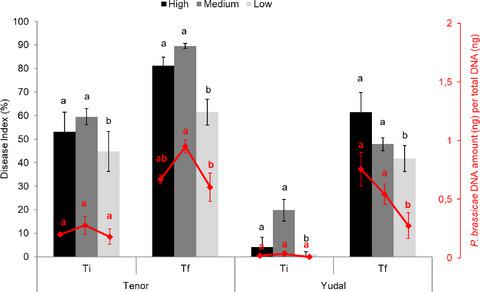当前位置:
X-MOL 学术
›
Microb. Biotechnol.
›
论文详情
Our official English website, www.x-mol.net, welcomes your
feedback! (Note: you will need to create a separate account there.)
Soil microbiota influences clubroot disease by modulating Plasmodiophora brassicae and Brassica napus transcriptomes.
Microbial Biotechnology ( IF 4.8 ) Pub Date : 2020-07-19 , DOI: 10.1111/1751-7915.13634 Stéphanie Daval 1 , Kévin Gazengel 1 , Arnaud Belcour 2 , Juliette Linglin 3 , Anne-Yvonne Guillerm-Erckelboudt 1 , Alain Sarniguet 4 , Maria J Manzanares-Dauleux 1 , Lionel Lebreton 1 , Christophe Mougel 1
Microbial Biotechnology ( IF 4.8 ) Pub Date : 2020-07-19 , DOI: 10.1111/1751-7915.13634 Stéphanie Daval 1 , Kévin Gazengel 1 , Arnaud Belcour 2 , Juliette Linglin 3 , Anne-Yvonne Guillerm-Erckelboudt 1 , Alain Sarniguet 4 , Maria J Manzanares-Dauleux 1 , Lionel Lebreton 1 , Christophe Mougel 1
Affiliation

|
The contribution of surrounding plant microbiota to disease development has led to the ‘pathobiome’ concept, which represents the interaction between the pathogen, the host plant and the associated biotic microbial community, resulting or not in plant disease. The aim herein is to understand how the soil microbial environment may influence the functions of a pathogen and its pathogenesis, and the molecular response of the plant to the infection, with a dual‐RNAseq transcriptomics approach. We address this question using Brassica napus and Plasmodiophora brassicae, the pathogen responsible for clubroot. A time‐course experiment was conducted to study interactions between P. brassicae, two B. napus genotypes and three soils harbouring high, medium or low microbiota diversities and levels of richness. The soil microbial diversity levels had an impact on disease development (symptom levels and pathogen quantity). The P. brassicae and B. napus transcriptional patterns were modulated by these microbial diversities, these modulations being dependent on the host genotype plant and the kinetic time. The functional analysis of gene expressions allowed the identification of pathogen and plant host functions potentially involved in the change of plant disease level, such as pathogenicity‐related genes (NUDIX effector) in P. brassicae and plant defence‐related genes (glucosinolate metabolism) in B. napus.
中文翻译:

土壤微生物群通过调节甘蓝根霉和甘蓝型油菜转录组来影响根肿病。
周围植物微生物群对疾病发展的贡献催生了“病原组”概念,它代表病原体、宿主植物和相关生物微生物群落之间的相互作用,导致或不导致植物疾病。本文的目的是通过双 RNAseq 转录组学方法了解土壤微生物环境如何影响病原体的功能及其发病机制,以及植物对感染的分子反应。我们使用甘蓝型油菜和甘蓝根肿菌(引起根肿病的病原体)来解决这个问题。进行了一项时程实验来研究甘蓝型油菜、两种甘蓝型油菜基因型和三种具有高、中或低微生物群多样性和丰富度的土壤之间的相互作用。土壤微生物多样性水平对疾病发展(症状水平和病原体数量)有影响。甘蓝型油菜和甘蓝型油菜的转录模式受到这些微生物多样性的调节,这些调节取决于宿主基因型植物和动力学时间。基因表达的功能分析可以识别可能参与植物疾病水平变化的病原体和植物宿主功能,例如甘蓝中的致病性相关基因(NUDIX效应子)和白菜中的植物防御相关基因(芥子油苷代谢)B. 甘蓝型油菜。
更新日期:2020-07-19
中文翻译:

土壤微生物群通过调节甘蓝根霉和甘蓝型油菜转录组来影响根肿病。
周围植物微生物群对疾病发展的贡献催生了“病原组”概念,它代表病原体、宿主植物和相关生物微生物群落之间的相互作用,导致或不导致植物疾病。本文的目的是通过双 RNAseq 转录组学方法了解土壤微生物环境如何影响病原体的功能及其发病机制,以及植物对感染的分子反应。我们使用甘蓝型油菜和甘蓝根肿菌(引起根肿病的病原体)来解决这个问题。进行了一项时程实验来研究甘蓝型油菜、两种甘蓝型油菜基因型和三种具有高、中或低微生物群多样性和丰富度的土壤之间的相互作用。土壤微生物多样性水平对疾病发展(症状水平和病原体数量)有影响。甘蓝型油菜和甘蓝型油菜的转录模式受到这些微生物多样性的调节,这些调节取决于宿主基因型植物和动力学时间。基因表达的功能分析可以识别可能参与植物疾病水平变化的病原体和植物宿主功能,例如甘蓝中的致病性相关基因(NUDIX效应子)和白菜中的植物防御相关基因(芥子油苷代谢)B. 甘蓝型油菜。











































 京公网安备 11010802027423号
京公网安备 11010802027423号